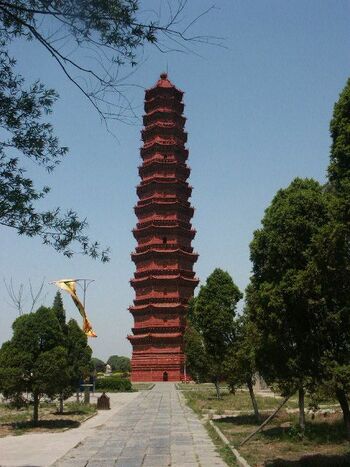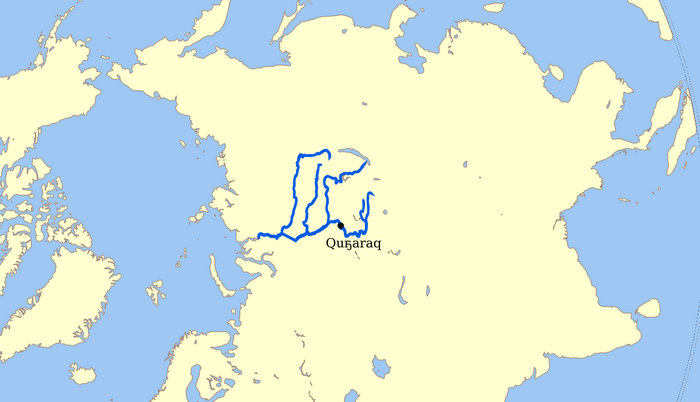
The Bronze Pagoda of Quҕaraq, a Buddhist monument. Great public works appear in most Quҕaraq cities.
Dawn of Quҕaraq[]
In 753 BCE a civilization arose along the Yenisei river in Siberia centered around the city of Quҕaraq (Chu-gha-rach). It established trade and other intercourse with the neighboring Zhou Dynasty (周朝) China and associated states and looked to the Chinese for learning and refinement.
Beginning of the Empire[]
When the troublesome Xiongnu (匈奴) barbarians began to disturb both the lands of China and Quҕaraq's trade routes and client states it was the soldiers of the Quҕaraq who subdued them and proceeded to forge the Xiongnu into a powerful ally and cavalry force. The defeat of the Xiongnu only whetted the appetite of the craggy, wind-hardened men of Quҕaraq and spurred them on to cast their reach across the Siberian plains.
The Gaoche (高車), then the Donghu (东胡), the wandering Da Yuezhi (大月支) who in another time would have conquered Northern India, even the Gojoseon (고조선) kingdom of Korea fell under the rule of Quҕaraq.
But it was a rule enlightened by Chinese philosophy and wisdom and civilized by the application of Chinese custom and the best methods of the Hundred Schools of Thought (諸子百家). Quҕaraq lords and administrators were steeped in the Five Classics (五經) and the Four Books (四書) and so it was through the stick of a mighty military and the dual carrot of trade and civilizing influence that Quҕaraq brought Chinese culture, philosophy, and wares to an empire stretching across the great Siberian plains and beyond and made barbarians no longer barbarians, all while the descendant-states of the Zhou fought and squabbled amongst themselves.
Conquest of China[]
And it came to be that the student had surpassed the master. The great Quҕaraq armies, organized in the Chinese fashion and equipped with the most advanced Chinese-style arms, led by generals well studied in Master Sun's Military Strategies (孫子兵法) were the ones who subdued Han state after Han state, and when finally China found itself unified - it was unified beneath a Quҕaraq banner. But this would not be the evanescent rule of an interloping barbarian aristocracy; no, the center of gravity of the eastern World had shifted north, to a seat at the mighty city upon the Yenisei. As the Hellenic Empires and the Hellenic world ceded that world's center to Rome now China had handed down the center of the Eastern world to Quҕaraq.
Notes[]
The map depicts a polar projection of northern Asia. Quҕaraq is located in approximately the same location as OTL Krasnoyarsk (Красноярск).
"Quҕaraq" and other terms are intended to be based upon the Ket language on which many details are accessible through the Moscow State University's Multimedia Database of Ket language.
![]() This alternate history related article is a stub. Please add suggestions on the talk page.
This alternate history related article is a stub. Please add suggestions on the talk page.

